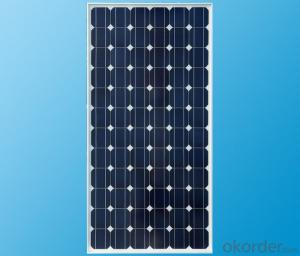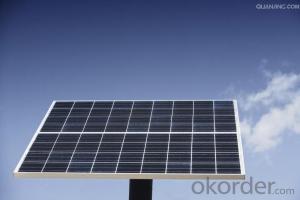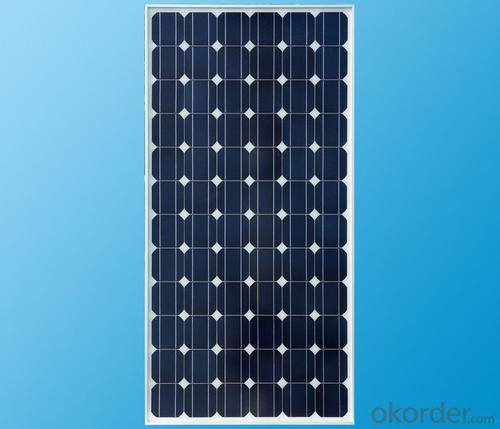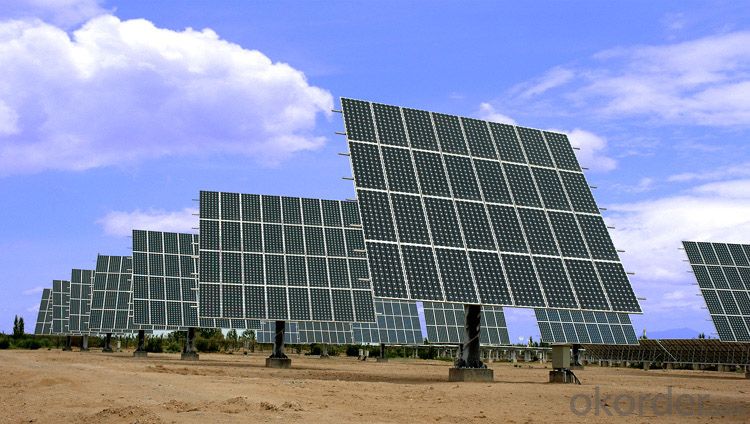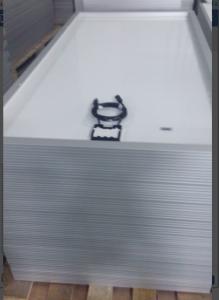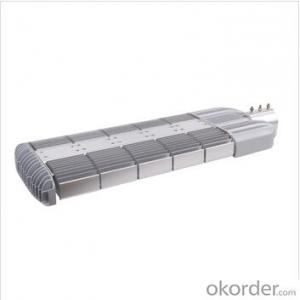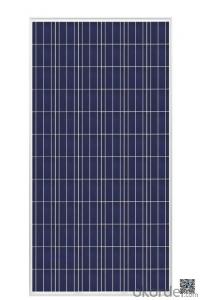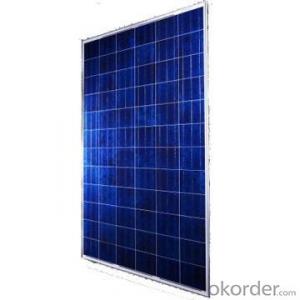Solar Panels Farms for Home in Brand Sunnypower with All Certificates
- Loading Port:
- China Main Port
- Payment Terms:
- TT or LC
- Min Order Qty:
- -
- Supply Capability:
- 10000000000000 watt/month
OKorder Service Pledge
OKorder Financial Service
You Might Also Like
1.Structure of Solar Module Description
CNBM Solar's photovoltaic module is designed for designed for large electrical power requirement. It is the optimal choice for both on-grid and off-grid power systems. CNBM Solar offers high performance of power per square foot of solar array.
2.Main Features of the Solar Module
Solar Cell: High efficency crystalline solar cell. Even if under the weak light, the solar module can produce maximum power output.
Tempered glass: Anti-reflecting coating and high transmission rate glass increase the power output and mechanical strength of solar module.
EVA and TPT: Using high quality EVA and TPT to prevent destroying and water.
Strong aluminum frames to strengthen the load hold and to stand against high wind.
Junction box: Multi function junction box with water proof.
Long lifetime: ≥25 years; Less power decrease.
Good performance of preventing from atrocious weather such as wind and hails.
Resisting moisture and etching effectively, not effected by geology.
The certificate issued by international authority: UL, TUV, IEC, VDE, CE.
Quick Details
| Place of Origin: | Guangdong China (Mainland) | Brand Name: | SunnyPower | Model Number: | SPM |
| Specification: | Normal | Application: | Home | Output Voltage (V): | 12VDC 24V DC |
| Load Power (W): | Depands | Solar Power (W): | 5W--300W | Certification: | VDE,IEC,CSA,UL,CEC,MCS,CE,ISO,ROSH |
| Size: | Customized dimensions | Max power: | 5W---300W | Cable: | MC-4 and connector |
| Frame: | White or black aluminum | Glass: | Low iron tempered glass | Cell type: | Mono crystalline and Poly crystalline |
| Cell brand: | Taiwan Motech | System voltage: | 12v or 24v |
Packaging & Delivery
| Packaging Detail: | Each panel with one single caton,and then 10pcs/5pcs with one outer carton,finally use wooden pallets to pack the cartons. |
| Delivery Detail: | 20 days |
3.Solar Module Images
4.Solar Module Specification
Solar Panels from 5W--300W, made of TAIWAN MOTECH brand cells,with CO in TAIWAN,Mono and Poly with VDE,IEC,CSA,UL,CE,ISO.
We import solar cells from Taiwan Motech brand, with this CO in taiwan and our CSA certification,we can still sell goods to Anti-dumping areas like USA. Our main products are solar panels, off grid and on grid solar home systems , solar street lighting systems, solar water heating system,solar pump,solar attic fan, solar DC LED lights and solar DC refrigerators.
Certificates : ISO, CE, VDE IEC, MCS, CSA-UL, CEC.
Delivery time: sample 10days, order 25-30days.
Sample: charged.
Payment term: T/T 30% as deposit, 70% before shipment. Or irrevocable L/C at sight.
Trade term: FOB Shenzhen or CIF destination seaport or Airport.
5.FAQ of Solar Module
1. Q: Do you have your own factory?
A: Yes, we have. Our factory located in Jiangyin city, jiangsu province.
2. Q: How can I visit your factory?
A: Before you take off from your country, please let us know. We will show you the way,or arrange time to pick you up if possible.
3. Q: Do you provide free sample?
A: Usually we do not offer free sample
4. Q: Could you print our company LOGO on the nameplate and package?
A: Yes, we can do that.
- Q: How do solar panels affect the overall resilience of a building?
- Solar panels can greatly enhance the overall resilience of a building by providing a reliable and sustainable source of electricity. By generating clean energy from the sun, solar panels reduce dependency on traditional power grids, making the building less susceptible to power outages and fluctuations. Additionally, solar panels can continue to operate during extreme weather events, ensuring a constant power supply. This increased energy independence and stability make the building more resilient and better equipped to withstand challenges and disruptions.
- Q: I am interested in installing a home solar panel system. In my city, we get a little over 5 hours of sun, and I typically use about 800-900 kwh per month.The available roof space is small- approximately 600 sqft.The online calculators provided on various sites are not uniform, thus providing inconsistent responses with the same input data.I think I need a 5kw system approximately. Can anyone verify that and provide a link for a reasonably priced system to meet my needs? Prefer grid-tied, but off-grid is acceptable as well.Thanks!
- And at what tilt? Are there trees, poles, or buildings that cast a shadow on the roof at any time? Is the space clear of vent pipes (these can be moved, but it's extra work and cost)? Probably your best move is to contact a solar installer, and get a free quote on a system. Have them quote a system that you own, not a lease. They will do an analysis of your home, which will be very valuable even if you decide not to use a professional. If there are no professional installers in your area, that's an indication that your area may not be good for solar.
- Q: Are there any restrictions or regulations regarding solar panel installations?
- Yes, there are restrictions and regulations regarding solar panel installations. These can vary depending on the location and jurisdiction. Common regulations include obtaining permits, adhering to building codes and zoning requirements, maintaining a certain distance from property lines, and complying with electrical and safety standards. It is important to consult with local authorities and professionals to ensure compliance with all applicable regulations before installing solar panels.
- Q: I've seen a couple homes around my town that have solar power and I live in the Desert, where the sun is shinning and it gets really hot during the summer. We run our air conditioner a lot making our electricity bill high.So I just wanted to know if anyone has or knows anyone that has solar panels? are they worth getting and is it the same as having electricity?
- and, if given the tax credits, you'll see a faster return on investment in CA than I would have in Western PA (I was given a 0 year return number without factoring any tax credits). Plus you'll be doing something good for the environment. My brother put his house for sale which had solar panels for hot water, and was offered good money for the solar panels independent of selling the house. If anyone has a any no answer that doesn't involve the initial expense, I'm looking forward to reading it.
- Q: Can solar panels be used to power a university?
- Yes, solar panels can be used to power a university. Solar energy is a renewable and clean source of power, making it an ideal solution for large institutions like universities. By installing solar panels on rooftops, parking lots, or open spaces, universities can generate a significant amount of electricity to meet their energy needs. Additionally, universities often have large campuses with ample space for solar panel installations, making it feasible to generate a substantial amount of solar power.
- Q: Actually I want to convert my home electricity on Solar Panel to cut down electricity costI have 2 AC's, a refrigerator, 3 Television, 2 Computers, 4 Fans etc
- good okorder lots of good ideas there
- Q: I was watching an idiot abroad, and I saw a family that lived in tent like huts, with no plumbing. And they had a solar panel, now if they can afford it, I know I can. Where do you get cheap ones?
- you okorder . all you have to do is watch the video.
- Q: Can solar panels be installed on tall buildings?
- Yes, solar panels can be installed on tall buildings. In fact, tall buildings are often ideal for solar panel installations as they typically have more available roof space to accommodate a larger number of panels. Additionally, being elevated, tall buildings are less likely to be obstructed by shading from surrounding structures or trees, maximizing their exposure to sunlight and optimizing energy generation.
- Q: Can solar panels be installed on mobile homes?
- Yes, solar panels can be installed on mobile homes.
- Q: i trying to make a solar panel. right now i dont have money to go and buy a copper sheet. so can i make it out of aluminum foil. if there is a way please tell me how. and what do i use for wires. i making this to charge batteries.
- Homemade okorder
Send your message to us
Solar Panels Farms for Home in Brand Sunnypower with All Certificates
- Loading Port:
- China Main Port
- Payment Terms:
- TT or LC
- Min Order Qty:
- -
- Supply Capability:
- 10000000000000 watt/month
OKorder Service Pledge
OKorder Financial Service
Similar products
Hot products
Hot Searches
Related keywords
